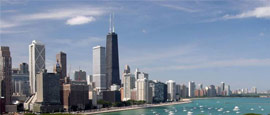Chicago History
Chicago's history began with the arrival of French explorers, missionaries and fur traders in the late 17th century.
The territory was claimed by the United States in the late 18th century, at which time the area was inhabited by the Potawatomi Indians. By the 1830s, the population was only a few hundred but entrepreneurs saw the potential to create a transport hub.
The first commercial schooner sailed into the harbour via the Great Lakes, a sign of the trade that was to mushroom between the city and New York State. This was augmented by the development of rich farmlands, which attracted Yankee settlers and encouraged the construction of roads and docks to load ships with farm produce to send eastwards.
By 1840, the population had boomed to 4,000. Eight years later, a canal and railway line opened and Chicago fast became the transportation hub of the United States with its road, rail, water and later air connections.
In a period of two decades, the population reached 90,000, thanks to the arrival of Irish Catholics fleeing the Great Famine and rising numbers of European immigrants. By 1900, Chicago grew to nearly 1.7 million people, at the time the fastest-growing city ever.
With the era of Prohibition, the 1920s brought international notoriety to Chicago. Bootleggers and smugglers brought in liquor from Canada and formed powerful gangs. The most notorious was Al Capone.
After WWI, tens of thousands of African Americans arrived in the city, and social tensions rose. Competition for jobs and housing sparked race riots in 1919 in which many blacks died.
Nevertheless, the arrival of migrants and immigrants continued throughout the 20th century – Hispanics, Mexican Puerto Ricans and Cubans from the 1940s and Indians and Chinese from the 1970s.
The then Sears Tower was built in 1974 to become the world’s tallest building, a symbol of the city’s confidence.
Since, the 1990s, attempts have been made to revitalise inner city neighbourhoods, whilst more recently, attempts have been made to create a greener city, with the development of gardens on top of flat skyscrapers and the creation of Millenium Park.
Did you know?
• The name "Chicago" is believed to derive from the French version of the word shikaakwa ("Stinky Onion"), named for the plants grown along the Chicago River.
• In 1871, a fire destroyed 18,000 buildings, leaving 100,000 homeless and killing hundreds.
• In 1885 Chicago gave the world its first skyscraper, the 10-story Home Insurance Building.
Do you have any Feedback about this page?
© 2025 Columbus Travel Media Ltd. All rights reserved. No part of this site may be reproduced without our written permission, click here for information on Columbus Content Solutions.




 You know where
You know where